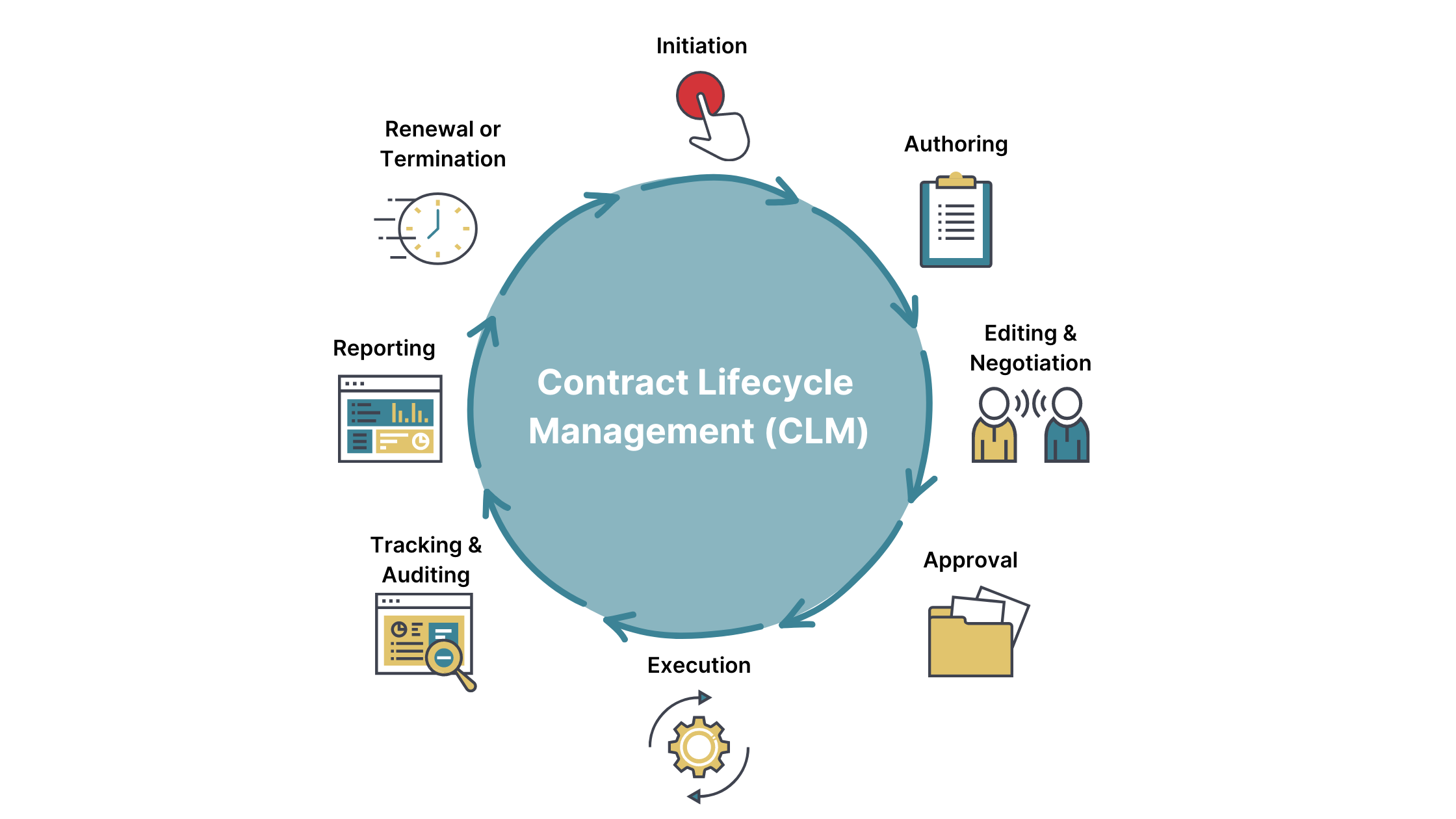Contract Management 101: Everything You'll Ever Need to Know

What is Contract Management?
Contract management or contract lifecycle management (CLM) is the process of managing contracts, from the creation through to execution, and eventually termination or renewal of the contract.
Key activities involved in contract management include contract drafting and clause negotiation, performance analysis to maximize operational and financial performance and risk mitigation, both financial and reputational (e.g., business relationships get damaged by defaulting on contract terms).
Why is Contract Management Important?
Contracts are the foundation of business relationships. They spell out every aspect of a business deal or supplier relationship from start to finish.
A study shows that the average Fortune 1000 company has an average of 40,000 active contracts on a given day.
Think about that for a second.
40,000 times that a contract needs to be authored, reviewed, negotiated, approved, and that’s just the beginning.
All contracts then need to be managed for their entire lifecycle, leveraging any negotiated clauses, monitored for compliance, and then reviewed again for renewal or amendments.
A single contract pulls in people from finance, legal and procurement, all needing to handle things manually.
This is time-consuming and costly for one, but these manual and repetitive processes are very error-prone which leads to further costs, missed deadlines, and compliance issues.
That’s just for one contract.
Without proper contract management, you open yourself up to countless risks, financial penalties, and procurement contract compliance issues.
A small technical mistake or wording issue can cost thousands of dollars in the long run.
What are the Stages of Contract Lifecycle Management (CLM)?

An average contract’s lifecycle can be split into two distinct parts, pre-signature and post-signature, each coming with its own challenges and responsibilities.
Pre-signature:
Encompasses the initial authoring of a contract, negotiations, editing, and approvals. This is largely a cross-departmental undertaking, relying mostly on manual tasks and negotiations.
- Contract Initiation: This is where the need for a contract is identified, and the contract lifecycle begins. Maybe you are starting to work with a new supplier vendor, there needs to be a contract in place to set the guardrails for the business relationship.
- Authoring: The contract needs to be written. Consider this more of a rough draft than a final product.
- Negotiation: Both parties need to look at the proposed draft and rule out any changes that should be made. Certain clauses will need to be negotiated to ensure that each side is getting maximum value.
- Editing: After all negotiations are through, it’s time to finalize those edits. Contract management software really comes in handy here by tracking all changes and allowing for easy comparison between versions.
- Approval: This is typically where the most bottlenecks occur. You need a clear process and set of workflows in place to keep the approvals process running smoothly. This can be aided by contract and workflow automation software.
Post-signature:
Deals with contract management and enforcement, along with the renewal and amendment process. This is ongoing throughout the entire length of the contract and details can easily be missed when dealing with a large volume of varyingly complex contracts.
- Execution: Now that the contract has been signed, it’s time to execute the agreement. However, done manually, this can lead to quite a bit of risk and missed opportunities. Contracts can be quite lengthy, and some clauses can be hidden. Using contract management software can easily allow you to identify risky clauses or opportunities for more value.
- Tracking: Tracking performance across the entire contract lifecycle is crucial, not only to ensure compliance and you are getting the most value possible but also to inform you whether this is a contract worth renewing or terminating.
- Auditing: Occasionally, you should run a full audit of all open or recently closed contracts. This will give you an in-depth look at your contract performance, open clauses and what your next steps look like.
- Reporting: Tracking the data is one thing, but without a central and intuitive dashboard or repository the data will be hard to read and analyze. Good CLM software will give a “single source of truth” for your contract data and help to bring actionable insights to guide your decision-making.
- Renewing: You’ve seen the contract through its lifecycle. Time to make a decision, will you renew, renegotiate or terminate? Unfortunately, when done manually, most companies miss out on renewal opportunities and lose thousands of dollars of potential value. Remember, many companies have upwards of 40,000 open contracts at a time, this makes it extremely difficult to track manually, but with automated workflows, you can always have one eye on upcoming expirations.
What is Contract Management Software?
Traditionally you think of contract management, and you think of a filing cabinet and dozens of folders.
If you’re still keeping your contracts in a filing cabinet, on a shared drive, or sending scanned copies of the final version via email, you’re not the only one. It’s amazing how many billion-dollar companies still rely on paper.
However, as I’m sure you’ve gathered so far, that manual practice is full of inefficiencies and risks that take away from the incredible value that contract management can bring.
Contract management software is an electronic approach to solving all of these manual problems.
From organizing paperwork, authoring contracts, negotiating and redlining, managing dates, reporting on performance and automating workflows, contract management software can take the friction out of the entire contract lifecycle.
Modern AI-Powered contract management can even use the power of AI to take clause authoring, risk management, and prescriptive analytics to the next level.
Integrated contract management software can free up countless man-hours and automate all of the processes associated with managing the contract lifecycle, creating more bottom-line value for your company.
10 Benefits of Contract Management Software
There are tons of ways that contract management software can bring value to you.
Here are 10 of the top ways to simplify your life with contract management software:
1. Standardize Your Contracts
Stop recreating the proverbial wheel. With a contract management software tool, you can choose from a library of templates and clauses to ensure consistent contract text and clauses company-wide. Now you can put an end to NDAs spread across the company in six different versions.
2. Make Monitoring and Tracking Contract Changes Easy
No more worrying about version control. All text changes, whether they are internal or external, are redlined automatically and can be easily accepted or rejected.
3. Streamline Your Contract Approval Process
Stop wasting time trying to figure out who needs to review a contract and then chasing that person down. The approval workflow makes sure the right items are approved and recorded on time by the right people.
4. Store All Your Contracts in One Place
Say goodbye to tracking down contracts. A contract lifecycle management (CLM) tool with a contract repository is a convenient way to store contracts and related documents so stakeholders can access them securely and easily – from any part of the globe.

5. Set Automated Contract Alerts
Never worry about missing something important. Set custom alerts that appear in your email and never miss expiration dates or deliverable due dates again.
6. Find Your Contracts Faster
Don’t lose time searching for the right contracts. Find a contract by searching for a keyword or a phrase. You can even search attachments to a contract – for example, insurance certificates.
7. Take Advantage of E-signature Technology
Stop worrying about tracking down the VP for their John Hancock. It only takes a few minutes and works just like a physical signature.
8. Simplify Your Contract Negotiation Process
Graduate from printing and scanning PDFs. Contract revisions can go back and forth between you and your client via email.
9. Integrate with your ERP
No more manually moving data. Our contract management software can operate as a standalone tool or plug into your ERP to sync with main customer lists, vendor lists and users.
10. Save Time and Money!

Don’t waste time manually completing tasks you can automate. One customer realized a 50 percent improvement in contract cycle time from automation.
Of course, not all contract management software is created equal. Some have integrated AI embedded throughout the solutions to provide even more automation and value.

